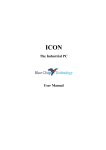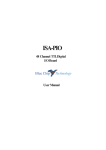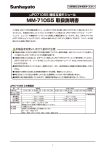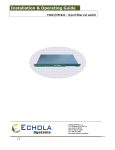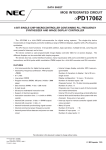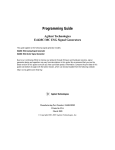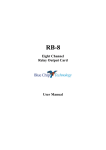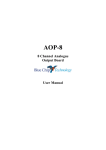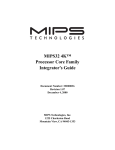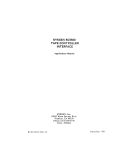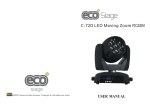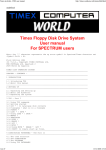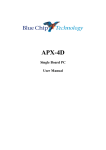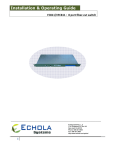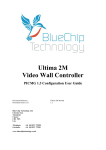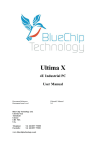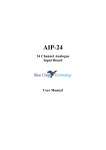Download PIO 96 Data Acquisition Card User Manual
Transcript
PIO-96 96 Channel Programmable Input/Output Board User Manual PIO-96 User Manual Document Part N° Document Reference Document Issue Level 0127-1015 0127-1015.Doc 1.2 Manual covers PCBs identified PIO-96 Rev B All rights reserved. No part of this publication may be reproduced, stored in any retrieval system, or transmitted, in any form or by any means, electronic, mechanical, photocopied, recorded or otherwise, without the prior permission, in writing, from the publisher. For permission in the UK contact Blue Chip Technology. Information offered in this manual is correct at the time of printing. Blue Chip Technology accepts no responsibility for any inaccuracies. This information is subject to change without notice. All trademarks and registered names acknowledged. Blue Chip Technology Ltd. Chowley Oak, Tattenhall Chester, Cheshire CH3 9EX. Telephone : 01829 772000 Facsimile : 01829 772001. Amendment History Issue Level 1.1 1.2 Issue Date Author 24.11.97 SEJ Amendment Details First draft Window front cover and logo. See ECN 98/088 Contents 1.0 INTRODUCTION.......................................................................... 1 ELECTROMAGNETIC COMPATIBILITY (EMC)................................. 2 EMC Specification ......................................................................... 3 2.0 USER ADJUSTMENTS ................................................................ 4 2.1 Selecting the Base Address (JP1) ............................................ 4 2.2 Setting the Interrupt Channel (JP2) .......................................... 6 3.0 PORT MAP .................................................................................. 7 3.1 Control Port Bit Functions ........................................................ 8 4.0 ELECTRICAL OPTIONS .............................................................. 9 4.1 Input Conditioning .................................................................... 9 4.2 Input/Output Connections......................................................... 9 4.3 Connector Pin Details............................................................. 11 5.0 OPERATING GUIDE.................................................................. 12 5.1 Using the Device.................................................................... 12 5.2 Programming Guide ............................................................... 13 Simple Inputs ............................................................................... 13 Simple Outputs ............................................................................ 13 Typical Register Setups ............................................................... 15 6.0 EXAMPLE PROGRAMS............................................................. 16 Example Program 1 ..................................................................... 16 Example Program 2 ..................................................................... 17 7.0 COMMERCIAL DATA ACQUISITION PACKAGES .................... 20 7.1 Use of the PIO-96 Board with ASYST .................................... 20 APPENDIX....................................................................................... 21 A1 I/O Address Map for PC/XT/AT Computers ............................ 21 A2 Hardware Interrupt Levels for PC/XT ...................................... 22 A3 Hardware Interrupt Levels for PC/AT ...................................... 23 DMA Channels............................................................................. 23 Blue Chip Technology Ltd. 01271015.doc Introduction 1.0 Page 1 INTRODUCTION This card provides 96 programmable digital I/O lines. It is suitable for sensing or driving TTL connections only. There is provision for a set of on board pull up resistors to enable the board to be used to detect contact closures on push buttons, relay contacts etc. This manual refers to printed circuit boards identified (on the rear of the board) by the reference “PIO-96 Rev. B”. Whilst every effort has been taken to ensure that the information provided is accurate, Blue Chip Technology cannot assume responsibility for any errors in this manual or their consequences. Should any errors be detected, the company would greatly appreciate being informed of them. A policy of continuous product development is operated, resulting in the contents of this document being subject to change without notice. Blue Chip Technology Ltd. 01271015.doc Page 1 Page 2 Electromagnetic Compatibility (EMC) ELECTROMAGNETIC COMPATIBILITY (EMC) This product meets the requirements of the European EMC Directive (89/336/EEC) and is eligible to bear the CE mark. It has been assessed operating in a Blue Chip Technology Icon industrial PC. However, because the board can be installed in a variety of computers, certain conditions have to be applied to ensure that the compatibility is maintained. It meets the requirements for an industrial environment ( Class A product) subject to those conditions. • The board must be installed in a computer system which provides screening suitable for the industrial environment. • Any recommendations made by the computer system manufacturer/supplier must be complied with regarding earthing and the installation of boards. • The board must be installed with the backplate securely screwed to the chassis of the computer to ensure good metal-to-metal (i.e. earth) contact. • Most EMC problems are caused by the external cabling to boards. With analogue boards particular attention must be paid to this aspect. It is imperative that any external cabling to the board is totally screened, and that the screen of the cable connects to the metal end bracket of the board and hence to earth. It is recommended that round screened cables with a braided wire screen are used in preference to those with a foil screen and drain wire. Use metal connector shells which connect around the full circumference of the screen; they are far superior to those which earth the screen by a simple “pig-tail”. Standard ribbon cable will not be adequate unless it is contained wholly within the cabinetry housing the industrial PC. • If difficulty with interference is experienced the cable should also be fitted with a ferrite clamp as close possible to the connector. The preferred type is the Chomerics clip-on style, type H8FE-1004-AS. Page 2 01271015.doc Blue Chip Technology Ltd. Electromagnetic Compatibility (EMC) Page 3 • It is recommended that cables are kept as short as possible, particularly when dealing with low level signals. • Ensure that the screen of the external cable is bonded to a good RF earth at the remote end of the cable. Failure to observe these recommendations may invalidate the EMC compliance. Warning This is a Class A product. In a domestic environment this product may cause radio interference in which case the user may be required to take adequate measures. EMC Specification A Blue Chip Technology Icon industrial PC fitted with this card meets the following specification: Emissions: EN 55022:1995 Radiated Conducted Immunity: Class A Class A & B EN 50082-1:1992 incorporating Electrostatic Discharge IEC 801-2:1984 Performance Criteria B Radio Frequency Susceptibility IEC 801-3:1984 Performance Criteria A Fast Burst Transients IEC 801-4:1988 Performance Criteria B Blue Chip Technology Ltd. 01271015.doc Page 3 Page 4 User Adjustments 2.0 USER ADJUSTMENTS 2.1 Selecting the Base Address (JP1) The board may be located in any 62 pin ISA slot in the PC motherboard, but must be set up to appear at a specified position (or ‘address’) in the computer’s port map. Available positions are shown in the IBM-PC Technical Reference Guide. However, for those who do not possess a copy of this document a good place is the location normally allocated to the prototyping card as supplied by IBM. This address is 300 (hex) or 768 (decimal). All Blue Chip Technology cards are preset to this address at the factory. However, no two devices should be used while set to the same address since contention will occur and neither board will work. If your machine contains a card with a conflicting address then another reasonably safe address is 200 to 21F (hex). A set of links on the board set the base address of the board within the IBM-PC port map. The address is in binary with the presence of a link representing a 0 and the absence of a link representing a 1. Page 4 01271015.doc Blue Chip Technology Ltd. User Adjustments Page 5 To set the base address to 300 hex (768 decimal) set the pattern on the links as indicated below: JP1 10H 20H 40H 80H 100H 200H Figure 1 - Selecting the Base Address More example addresses are shown in Appendix A. Note: No Two cards must occupy the same address. Blue Chip Technology Ltd. 01271015.doc Page 5 Page 6 2.2 User Adjustments Setting the Interrupt Channel (JP2) The PIO-96 card supports the use of the interrupts generated from the µPD71055 chips. These chips are identical functionally to the Intel 8255 integrated circuit. The use of the interrupts provides a means to monitor digital inputs only when there has been a change at the input signal lines. The use of interrupts requires the user to write an interrupt handler routine (either in C or assembler) and install it prior to using the PIO-96 card. To select an interrupt channel, a link must be set on jumper block JP2. An interrupt is selected by placing a jumper link on the pair of link pins corresponding to the desired interrupt channel. All other interrupt channel links must be left open. Note: Only one link is permitted on JP2. If more than one link is fitted then the computer system may not function correctly. Figure 2 - Setting the Interrupt Channel The above diagram shows the jumper block JP2 with a link placed on interrupt channel 3. Please note that the silk screen printing of the interrupt numbers on the printed circuit board is incorrect. The diagram above shows the correct sequence. Page 6 01271015.doc Blue Chip Technology Ltd. Port Map 3.0 Page 7 PORT MAP The PIO-96 has four µPD71055 (8255) chips. Each chip has three 8 bit ports (A, B & C) which can be programmed as inputs or outputs by writing a control word to the control port. (See Table 2). All “A” ports and “B” ports much each be all input or all output, i.e. they should not be programmed to mixed input and output bits within an individual port. Port C may be split into two 4 bit sections each of which may be input or output. The board occupies sixteen read/write addresses (four for each µPD71055 chip) in the IBM-PC port map. ADDRESS Base + 0 Base + 1 Base + 2 Base + 3 Base + 4 Base + 5 Base + 6 Base + 7 Base + 8 Base + 9 Base + 10 Base + 11 Base + 12 Base + 13 Base + 14 Base + 15 PORT Port A Port B Port C Command Port 1 Port A’ Port B’ Port C’ Command Port 2 Port A’’ Port B’’ Port C’’ Command Port 3 Port A’’’ Port B’’’ Port C’’’ Command Port 4 Table 1 - Port Addresses Blue Chip Technology Ltd. 01271015.doc Page 7 Page 8 Port Map The function and operation of each of the input/output ports (A, B & C) are controlled by the control byte which is written to the appropriate Command Port. Each bit within the byte has a specific function, shown in Table 2. 3.1 Control Port Bit Functions BIT NO 7 FUNCTION Mode Set Flag 5, 6 4 Mode Selection Port A 3 Port C (Upper) 2 Mode Selection 1 Port B 0 Port C (Lower) SETTINGS 0=Inactive 1=Active 00=Mode 0 01=Mode 1 0=Output 1=Input 0=Output 1=Input 0=Mode 0 1=Mode 1 0=Output 1=Input 0=Output 1=Input Table 2 - Control Port - Bit Functions The software described in section 5 the Operating Guide gives examples of the more typical control bytes and their effects. Page 8 01271015.doc Blue Chip Technology Ltd. Electrical Options 4.0 ELECTRICAL OPTIONS 4.1 Input Conditioning Page 9 The 71055 has high impedance inputs. An option is provided to terminate external input lines. This is useful in an electrically noisy environment or where a load is required (e.g. open collector drive). The lines may be pulled up to the on-board +5V supply using 12 off SIL resistor packs (identified on the PCB as “RP1” to “RP6” and “RP11” to “RP16” inclusive). The recommended values of each resistor to 10Kohm. 4.2 Input/Output Connections Two 50 way insulation displacement connectors (IDC) are provided for I/O channel signal connection. One connector is located on the rear bracket and carries signals 1 to 48. The second connector is located on the board and carries signals 49 to 96. This connector may be brought out to the rear of the computer via an adapter cable. If access to individual channels is required, a 50 way IDC ribbon cable may be used to connect the I/O channels to a 50 way screw terminal block available from Blue Chip Technology as part number ST-24. The pins are numbered as shown in the following diagram. Pins 1-48 contain the I/O signal lines and pins 49 and 50 are connected to digital ground. Both connectors are identical in their pin-out. Blue Chip Technology Ltd. 01271015.doc Page 9 Page 10 Electrical Options When the connector is viewed from the back of the system odd numbered pins are on the left and even numbered pins are on the right with pin 1 at the top of the connector. Figure 3 - Connector Pin Details (P1 and P2) (View with gold edge connector facing downwards.) Page 10 01271015.doc Blue Chip Technology Ltd. Electrical Options 4.3 Page 11 Connector Pin Details PORT A (1) B (1) C (1) BIT NO. 0 1 2 3 4 5 6 7 0 1 2 3 4 5 6 7 0 1 2 3 4 5 6 7 Digital Ground PIN NO. 1 3 5 7 9 11 13 15 17 19 21 23 25 27 29 31 33 35 37 39 41 43 45 47 49 PIN NO. 2 4 6 8 10 12 14 16 18 20 22 24 26 28 30 32 34 36 38 40 42 44 46 48 50 BIT NO. 0 1 2 3 4 5 6 7 0 1 2 3 4 5 6 7 0 1 2 3 4 5 6 7 Digital Ground PORT A (2) B (2) C (2) Table 3 - Signal Pin Connection Details (Pin out of both connectors is identical) Blue Chip Technology Ltd. 01271015.doc Page 11 Page 12 Operating Guide 5.0 OPERATING GUIDE 5.1 Using the Device A total of 24 I/O channel signals from each 71055 I/O device on the PIO-96 board provides twelve 8-bit ports. Each signal is connected to one bit within one of these ports i.e. Page 12 01271015.doc Blue Chip Technology Ltd. Operating Guide 5.2 Page 13 Programming Guide Simple Inputs The state of the input lines may be determined by using either of the following methods: Microsoft BASIC A or GW BASIC. X=INP (P) Returns the byte from port P and assigns this value to the variable X. 8088/8086 Assembly language. PORT EQU 0300H GETDAT: MOV DX,PORT IN AL,DX RET Simple Outputs The state of the output lines may be modified by using either of the following methods: Microsoft BASIC A or GW BASIC. OUT P,D Outputs the byte D to Port P Blue Chip Technology Ltd. 01271015.doc Page 13 Page 14 Operating Guide 8088/8086 Assembly language PORT EQU 0300H PUTDAT: MOV DX,PORT MOV AX,DATA OUT DX,AL RET The µPD71055 can operate in one of 3 modes (mode 0, 1 & 2). In the first mode (mode 0) the µPD71055 provides simple I/O for three 8 bit ports. Data is simply written to, or read from a specified port (A, B or C) without the use of handshaking. Mode 1 enables the transfer of data to or from a specified 8 bit port (A or B) in conjunction with strobes or handshaking signals provided by Port C. In mode 2 data is transferred via one bi-directional 8 bit port (A) with handshakes (Port C). Page 14 01271015.doc Blue Chip Technology Ltd. Operating Guide Page 15 The following table gives a summary of the most commonly used ‘control words’ which must be written to each control port to configure the µPD71055s before using this module. The table assumes mode 0. Typical Register Setups Control Word (hex.) 80 81 82 83 88 89 8A 8B 90 91 92 93 98 99 9A 9B Control Word (Dec.) 128 129 130 131 136 137 138 139 144 145 146 147 152 153 154 155 Sets All of Port B As Output Output Output Output Output Output Output Output Input Input Input Input Input Input Input Input Sets High 4 Bits of Port B As Output Output Input Input Output Output Input Input Output Output Input Input Output Output Input Input Sets High 4 Bits of Port C As Output Output Output Output Input Input Input Input Output Output Output Output Input Input Input Input Sets Low 4 Bits of Port C As Output Input Output Input Output Input Output Input Output Input Output Input Output Input Output Input Table 4 - Simple I/O Control Words For a full explanation of the various modes of operating, and the use of the signal lines consult the Intel 8255 or NEC µPD71055 datasheet. Blue Chip Technology Ltd. 01271015.doc Page 15 Page 16 6.0 Example Programs EXAMPLE PROGRAMS Example Program 1 The following program in Microsoft Basic will test the operation of the PIO-96 if a link is made between corresponding pins on the rear of the connector. 10 P1=&H300 : REM BASE OF FIRST PIA 15 P2 = &H304 : REM BASE OF SECOND PIA 20 GOSUB 60 30 P1 = &H304 : P2 = &H300 40 GOSUB 60 50 GOTO 10 : REM LOOP CONTINUOUSLY 60 OUT P1+3, &H80 : OUT P2+3, &H9B 70 FOR P = 0 TO 2 80 F = 0 90 A = 1 100 OUT P1+P,A 110 IF INP(P2+P)<>A THEN PRINT “ERROR”, P,A,INP(P2+P):F=F+1 120 A=A+A 130 IF A=256 THEN GOTO 150 140 GOTO 100 150 IF F>0 THEN PRINT P, “FAILED”, F:GOTO 170 160 PRINT P,”PASSED” 170 NEXT P 180 RETURN The program runs continuously and can only be stopped by pressing Control-Break on the PC keyboard. Page 16 01271015.doc Blue Chip Technology Ltd. Example Programs Page 17 Example Program 2 This example program shows the use of interrupts generated from the µPD71055 PIO chip. The program sets mode 1 operation which allows data to be strobed into Port 0 of the first µPD71055 via a LOW signal on Port 2 bit 4. To determine when data has been strobed into the data port, this example polls the µPD71055 port 2 register which in mode 1 acts as a control/status register. In normal use an interrupt handler routine written in C or assembler would be resident in memory to respond to the hardware interrupt generated by the PIO card. NOTES: • Prior to using interrupts, an interrupt routine must be installed in memory by the application software. • To use interrupts ALL unused “INT0” and “INT1” lines (bits 0 and 3 of each µPD71055 port 2) must be LOW. This means that if a µPD71055 has been set to (say) mode 0 with all ports as output then Port 2 output lines 0 and 3 must be written to a zero (LOW) state. • If the ports were set to inputs then interrupts will only occur if Port 2 input lines 0 and 3 are LOW for each µPD71055 not being used in an interrupt mode. • The above is necessary because each µPD71055 “INT0” and “INT1” lines are logically OR-ed together. Blue Chip Technology Ltd. 01271015.doc Page 17 Page 18 Example Programs CLS bseaddr% = &H300 port0A% = bseaddr% + 0 port1A% = bseaddr% + 1 port2A% = bseaddr% + 2 ctrlprtA% = bseaddr% + 3 port0B% = bseaddr% + 4 port1B% = bseaddr% + 5 port2B% = bseaddr% + 6 ctrlprtB% = bseaddr% + 7 port0C% = bseaddr% + 8 port1C% = bseaddr% + 9 port2C% = bseaddr% + 10 ctrlprtC% = bseaddr% + 11 port0D% = bseaddr% + 12 port1D% = bseaddr% + 13 port2D% = bseaddr% + 14 ctrlprtD% = bseaddr% + 15 REM set µPD71055 No 2, 3 and 4 to mode 0 - all ports = outputs OUT ctrlprtB%, &H80 OUT ctrlprtC%, &H80 OUT ctrlprtD%, &H80 REM set all ports for µPD71055 Nos 2, 3 and 4 to LOW OUT port0B%, 0 OUT port1B%, 0 OUT port2B%, 0 OUT port0C%, 0 OUT port1C%, 0 OUT port2C%, 0 OUT port0D%, 0 OUT port1D%, 0 OUT port2D%, 0 Page 18 01271015.doc Blue Chip Technology Ltd. Example Programs Page 19 REM set mode 1 for normal operation for µPD71055 No 1 REM port 0 = input REM port 1 = input REM bits 7 and 6 of port C = input REM groups 0 and 1 set to mode 1 OUT ctrlprtA%, &HB0 REM set bit manipulation mode to set up µPD71055 chip No 1 REM and set bit 4 high to enable INT0 OUT ctrlprtA%, &H9 LOCATE 1, 1: PRINT "Port 0 of µPD71055 No1" rdval: REM get port data before interrupt dt% = INP(port0A%) pol: REM read input buffer full status (bit 5) for µPD71055 No 1 REM this determines when the data strobe has occurred irq% = (INP(port2A%) AND 32) IF irq% = 0 THEN GOTO pol LOCATE 3, 1: PRINT "Before Interrupt"; dt% rddat: REM read data from port 0 dta% = INP(port0A%) LOCATE 4, 1: PRINT "After Interrupt"; dta% SLEEP (1) GOTO rdval Blue Chip Technology Ltd. 01271015.doc Page 19 Page 20 7.0 Commercial Data Acquisition Packages COMMERCIAL DATA ACQUISITION PACKAGES The Blue Chip Technology PIO-96 can be used with almost any data acquisition package that can read information directly from a PC input port. 7.1 Use of the PIO-96 Board with ASYST The board has been tested with and is installable as an 71055.PORT digital device in the ASYST scientific software package by Macmillan Software Company. For more details about this package and other PC data acquisition software, please contact Blue Chip Technology. Page 20 01271015.doc Blue Chip Technology Ltd. Appendices Page 21 APPENDIX A1 I/O Address Map for PC/XT/AT Computers Address (Hex) 000-01F 020-03F 040-05F 060-06F 070-07F 080-09F 0A0-0BF 0F0 0F1 0F8-0FF 1F0-1F8 200-207 278-27F 2F8-2FF 300-31F 360-36F 378-37F 380-38F 3A0-3AF 3B0-3BF 3C0-3CF 3D0-3DF 3F0-3F7 3F8-3FF Allocated to DMA Controller 1, 8237A-5 Interrupt Controller 1, 8259A Timer, 8254 Keyboard Controller 8742; Control Port B RTC And CMOS RAM, NMI Mask (Write) DMA Page Register (Memory Mapper) Interrupt Controller 2, 8259 Clear NPX (80287) Busy Reset NPX, 80287 Numeric Processor Extension, 80287 Hard Disk Drive Controller Reserved Reserved For Parallel Printer Port 2 Reserved For Serial Port 2 Reserved Reserved Parallel Printer Port 1 Reserved For SDLC Comms, Bisynch 2 Reserved For Bisynch 1 Reserved Reserved Display Controller Diskette Drive Controller Serial Port 1 Blue Chip Technology Ltd. 01271015.doc Page 21 Page 22 A2 Appendices Hardware Interrupt Levels for PC/XT Address (Hex) 0 1 2 3 4 5 6 7 Page 22 Allocated to Timer Keyboard Reserved Asynchronous Communications (Secondary) SDLC Communications Asynchronous Communications (Primary) SDLC Communications Fixed Disk Diskette Parallel Printer 01271015.doc Blue Chip Technology Ltd. Appendices A3 Page 23 Hardware Interrupt Levels for PC/AT Address (Hex) 0 1 2 Timer Output 0 Keyboard(Output Buffer Full) Interrupt From Controller 2:8 9 10 11 12 13 14 15 3 4 5 6 7 Allocated to Real Time Clock Interrupt Software Redirected To INT(0AH) IRQ2 Reserved Reserved Reserved Co-Processor Fixed Disk Controller Reserved Serial Port 2 Serial Port 1 Parallel Port 2 Diskette Controller Parallel Port 1 DMA Channels 1 2 3 Floppy Disk Drive. (may be used when disk inactive) Hard Disk Drive Spare Blue Chip Technology Ltd. 01271015.doc Page 23





























